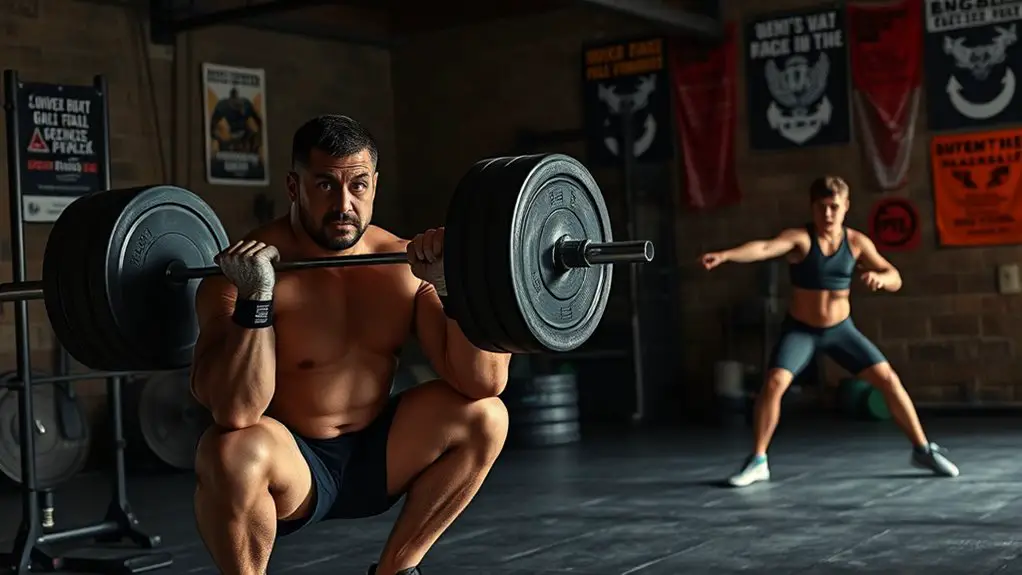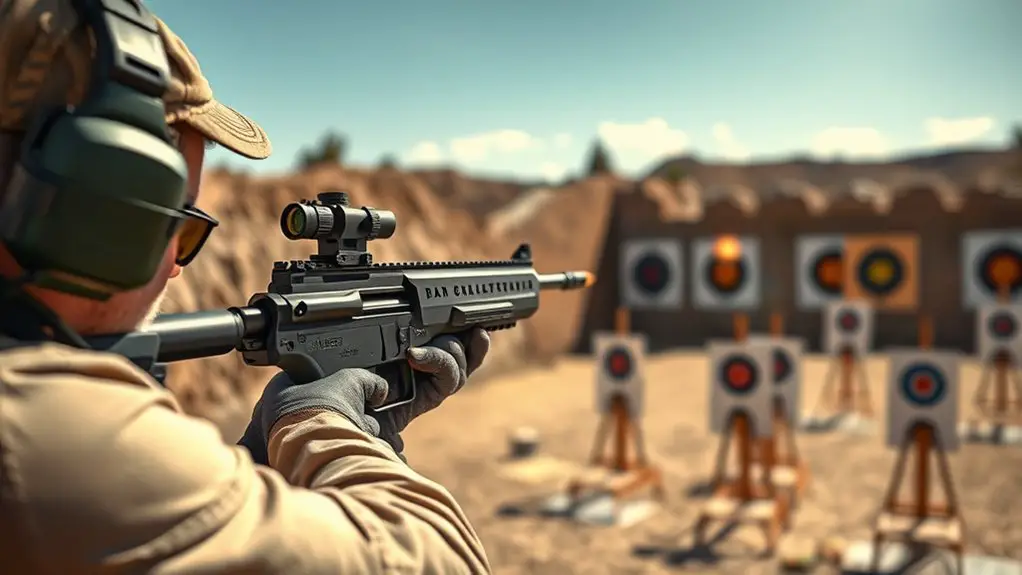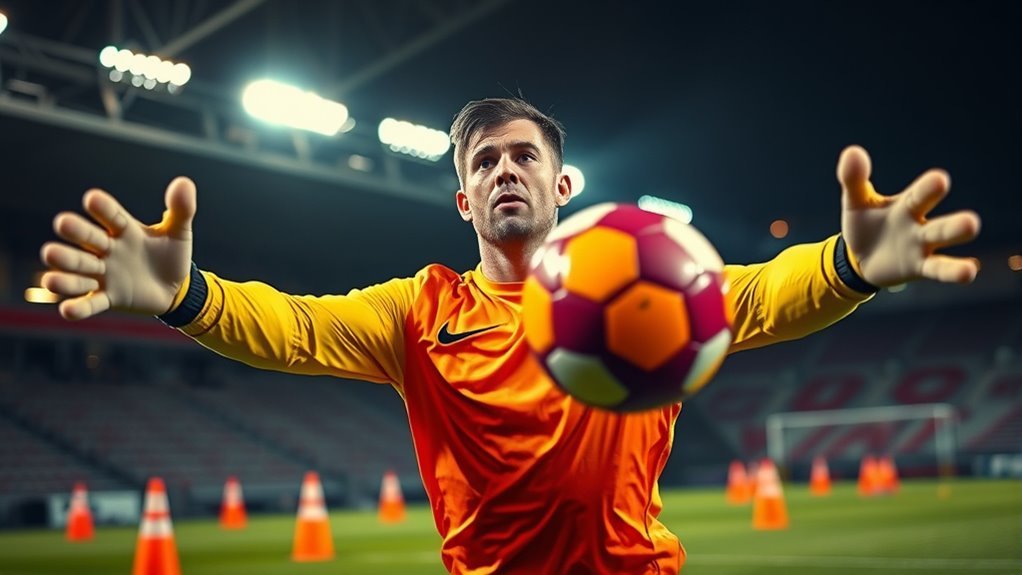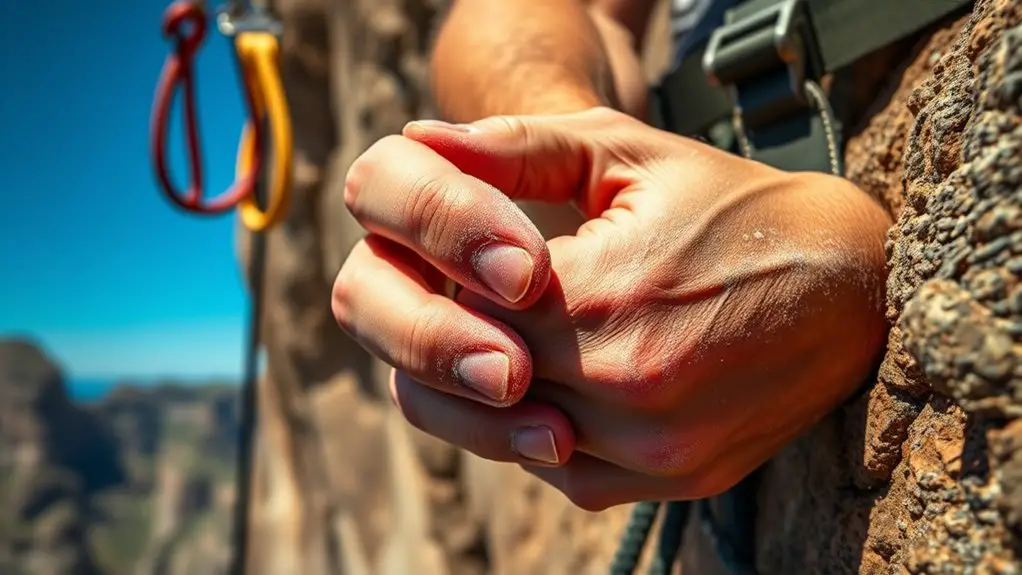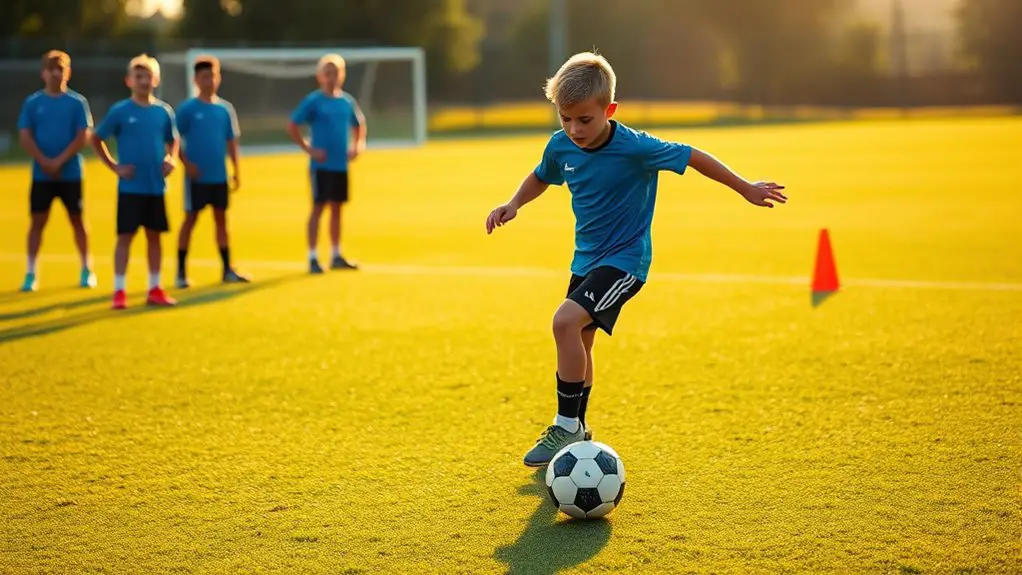Powerlifters focus on mastering core lifts—squat, bench press, and deadlift—while athletes often emphasize sport-specific skills and diverse movements. Your training volume and intensity are tailored to enhance strength through progressive overload, with careful attention to periodization. Recovery techniques and nutritional needs differ as well, with powerlifters prioritizing higher protein intake. Additionally, injury prevention strategies and specialized equipment play key roles in powerlifting. There's much more to uncover about these differences if you keep exploring.
The Core Lifts: Squat, Bench Press, and Deadlift
When you think of powerlifting, the core lifts—squat, bench press, and deadlift—immediately come to mind, as they form the foundation of this sport. Mastering these lifts gives you the freedom to explore your limits and push your strength. Squat variations, like front squats or box squats, help target different muscle groups and improve your overall performance. When you focus on your bench press, remember that adjusting your grip width can change the dynamics of the lift, allowing for better leverage and power. Deadlift techniques are equally important; experimenting with sumo versus conventional styles can reveal new levels of strength. By honing in on these core lifts, you not only build muscle but also cultivate a sense of empowerment. Incorporating squat variations into your routine can significantly enhance your athletic performance. Embrace the grind, and let these foundational movements guide you on your journey to becoming a stronger, freer version of yourself.
Training Volume and Intensity
While training volume and intensity might seem straightforward, they play a crucial role in a powerlifter's success. You'll want to focus on volume progression and intensity modulation to optimize your gains. This means gradually increasing the amount of weight and the number of sets or reps over time, while also varying your effort levels to prevent burnout. Adequate muscle recovery is vital to ensure that you can consistently progress without risking injury or overtraining.
Here's a quick overview of how to balance these elements:
| Training Aspect | Description | Frequency |
|---|---|---|
| Volume Progression | Gradually increase reps/sets | Weekly |
| Intensity Modulation | Vary weights and effort levels | Every training cycle |
| Recovery | Essential for growth and performance | As needed |
Specificity vs. Generalization in Training
When it comes to training, you've got to contemplate the balance between specificity and generalization. Targeted muscle development is key for powerlifters, but honing sport-specific skills can also play a vital role in your overall performance. Finding the right approach for your goals can make all the difference in your training regimen. Moreover, integrating strength training can enhance overall athletic performance and contribute to injury prevention.
Targeted Muscle Development
In the world of powerlifting, specificity reigns supreme when it comes to muscle development. You're not just building strength; you're honing in on targeted muscle groups to maximize gains. By applying muscle hypertrophy techniques and targeted strength training, you can sculpt your body to meet your goals. Here's what you should focus on:
- Compound lifts: Engage multiple muscle groups for overall strength.
- Accessory movements: Target specific muscles to address weaknesses.
- Progressive overload: Gradually increase weights to promote growth.
- Recovery: Allow muscles time to repair and strengthen.
These strategies provide the freedom to tailor your training routine, ensuring you develop the strength and physique you've always wanted. Embrace the journey of targeted muscle development!
Sport-Specific Skills
To excel in powerlifting, you need to focus on sport-specific skills that directly translate to performance in competition. Unlike general athletic training, powerlifting hones in on technique refinement for the squat, bench press, and deadlift. You'll find that mastering these lifts isn't just about raw strength; it's about skill acquisition that enhances efficiency and safety. Precision in your movements can make all the difference, allowing you to lift heavier while minimizing injury risk. By prioritizing these specific skills, you're not just building muscle; you're crafting a competitive edge. Embrace this targeted approach, and you'll discover that the freedom to lift effectively comes from a deep understanding of your craft, making every session count toward your goals.
Periodization and Programming Approaches
When you think about periodization and programming in powerlifting, it's all about maximizing your strength gains. You'll want to focus on specificity in your training while balancing volume and intensity effectively. This approach can lead to significant improvements in your performance over time.
Focus on Strength Gains
While many athletes might focus on general fitness, powerlifters zero in on strength gains through specialized periodization and programming approaches. This emphasis on strength progression allows powerlifters to tailor their training techniques to maximize performance.
Here are some key aspects of their training:
- Structured Phases: They break training into cycles, focusing on different strength attributes.
- Progressive Overload: Incrementally increasing weights guarantees consistent strength gains.
- Recovery Focus: Adequate rest is prioritized to enhance muscle growth and prevent burnout.
- Technique Optimization: They refine lifting form to increase efficiency and safety.
Specificity in Training
Powerlifters prioritize specificity in training to optimize their performance and achieve their lifting goals. By focusing on specific goals, they tailor their workouts to develop the exact strength needed for their lifts. This approach helps facilitate training adaptations that are vital for maximizing results. Instead of a one-size-fits-all routine, powerlifters implement periodization and programming strategies that revolve around their unique objectives. They cycle through phases of intensity and volume to guarantee their body adapts effectively, keeping progress on track. You'll find that honing in on the specific demands of powerlifting not only builds strength but also enhances overall athletic performance, allowing you the freedom to lift with confidence and purpose. Embrace this targeted training approach and watch your results soar.
Volume and Intensity Balance
To effectively balance volume and intensity, powerlifting programs often utilize periodization, ensuring that you're not only building strength but also preventing burnout and injury. By implementing various volume techniques and focusing on intensity management, you can optimize your training for maximum gains.
Here are some key points to reflect on:
- Cycle your lifts: Alternate between high-volume and high-intensity phases.
- Track your progress: Keep a log to adjust volume and intensity based on your performance.
- Incorporate deload weeks: Allow your body to recover while maintaining strength.
- Listen to your body: Adjust your training based on how you feel to avoid overtraining.
This approach gives you the freedom to train effectively while respecting your limits.
Recovery Strategies and Techniques
Although recovery might seem like a passive part of training, it's essential for maximizing your performance and preventing injury. Embracing various recovery strategies can release your potential and keep you feeling free. Here are some techniques you should consider:
| Strategy | Description | Benefits |
|---|---|---|
| Active Recovery | Light activities post-workout | Enhances blood flow and reduces soreness |
| Foam Rolling | Self-myofascial release | Releases muscle tightness and improves flexibility |
| Cold Therapy | Ice baths or cold packs | Reduces inflammation and speeds up recovery |
| Sleep Optimization | Prioritizing quality sleep | Enhances repair and mental clarity |
Incorporating hydration strategies, stretching routines, and massage therapy into your regimen can further enhance recovery. Don't forget mental relaxation and breathing techniques; they help you recharge mentally as well. Additionally, engaging in active recovery can significantly enhance circulation, promoting overall well-being. Balancing these elements will elevate your performance and keep you thriving.
Nutritional Needs for Strength vs. Performance
When it comes to optimizing your training, understanding the nutritional needs for strength versus performance is vital. Powerlifters and performance athletes often have different focuses, which can dramatically impact their dietary choices.
- Macronutrient ratios: Strength training may require higher protein sources, while endurance athletes might prioritize carbs.
- Meal timing: Eating before and after workouts can enhance strength gains or performance, depending on your goals.
- Hydration strategies: Staying hydrated is essential, but the timing and type of fluids can differ based on your activity.
- Supplement choices: While protein powders may be a staple for strength, performance might benefit from endurance-specific supplements.
Additionally, tracking energy levels and food responses can help in fine-tuning your nutrition for optimal athletic performance. Keep in mind your caloric intake and energy balance as you navigate meal prep. Tailor your nutritional approach to align with your dietary preferences and specific training goals for the best results!
Mental Focus and Mindset
Nutrition isn't the only factor that plays a significant role in powerlifting success; mental focus and mindset are just as important. To truly excel, you need to cultivate mental resilience and a competitive mindset. This isn't just about lifting weights; it's about embracing the process and overcoming challenges. Practicing visualization techniques can significantly enhance your performance by preparing you mentally for your lifts.
| Aspect | Powerlifting Focus | Athletic Focus |
|---|---|---|
| Mental Resilience | Overcoming setbacks | Quick recovery from loss |
| Competitive Mindset | Focused on personal PRs | Team success |
| Visualization | Picture your lifts | Envision team plays |
Injury Prevention and Management
Injury prevention and management are critical components of a powerlifter's training regimen, as even a minor setback can derail progress. To guarantee you stay on track, it's crucial to focus on proactive strategies.
- Regular injury assessment can help you identify potential issues before they escalate.
- Incorporate mobility work to maintain flexibility and joint health.
- Use proper lifting techniques to minimize strain on your body.
- Implement effective rehabilitation techniques if you do face an injury.
- Additionally, integrating proper warm-up techniques can significantly reduce the risk of injuries during training.
Equipment and Gear Differences
How does the right equipment enhance your powerlifting performance? When you step onto the platform, the gear you choose can make all the difference. Lifting belts provide much-needed support for your core, allowing you to maximize your lifts. Squat shoes, with their elevated heel, help you maintain balance and depth during squats. Wrist wraps stabilize your joints, while knee sleeves offer extra compression and warmth, protecting your knees.
Chalk usage is essential, ensuring a secure grip on the barbell, especially during heavy lifts. Different barbell types cater to varying lifts, whether you're squatting, benching, or deadlifting. Power racks and deadlift platforms create safe environments for your training, letting you push your limits without fear. Investing in quality gear isn't just about performance; it's about lifting freely and confidently. Your equipment is your ally in the pursuit of strength. Additionally, using compression gear can further enhance your performance by reducing fatigue and accelerating recovery.
Frequently Asked Questions
How Do Powerlifters Choose Their Training Partners?
When choosing a training partner, you might think it's just about lifting weights together, but it's so much more. You'll want someone with training compatibility—similar goals and schedules. A good partner can motivate you to push your limits and stay accountable. They should also encourage your freedom to explore different techniques. By finding someone who challenges you and supports your growth, you'll both thrive in your training journey.
What Role Does Competition Play in Powerlifting Training?
Competition plays an essential role in powerlifting training. It fosters a competition mindset, pushing you to elevate your performance under pressure. When you're preparing for a meet, that performance pressure can motivate you to train harder and focus on your goals. It's about embracing the thrill and challenge of competition, which helps you build mental resilience and refine your skills. Ultimately, it's this journey that allows you to express your strength and freedom.
How Do Powerlifters Handle Plateaus in Strength?
When you hit a plateau in strength, it's essential to mix up your training. You might try different strength strategies, like changing rep ranges or altering your workout split. Incorporating recovery techniques, such as active recovery days or improving your sleep and nutrition, can also help. Remember, it's all about finding what works for you and breaking free from stagnation. Embrace the journey, and you'll soon see progress again!
Are There Mental Techniques Specific to Powerlifting?
When it comes to mental techniques in powerlifting, visualization techniques can really help you. Picture yourself successfully completing lifts, which boosts your confidence. Focus strategies are equally important; they keep your mind clear and centered during intense moments. You might try deep breathing or positive affirmations to maintain that focus. By incorporating these techniques, you can break through mental barriers and elevate your performance, giving you the freedom to reach new heights in your training.
How Do Powerlifters Incorporate Cardio Into Their Routines?
You might think powerlifters focus solely on lifting heavy, but they actually incorporate cardio to enhance their overall performance. By integrating conditioning methods like HIIT or steady-state cardio, you can boost your cardiovascular health and recovery. These cardio benefits help maintain stamina during lifts and improve endurance for those longer training sessions. So, don't shy away from adding some cardio into your routine; it can elevate your lifting game considerably!
